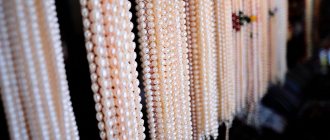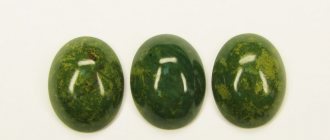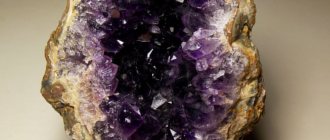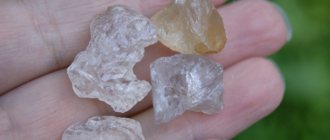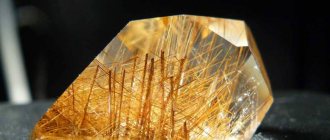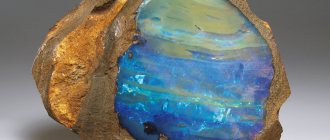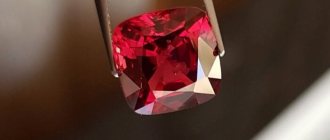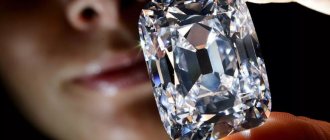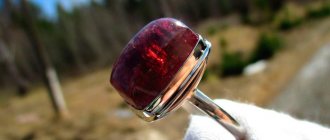Precious minerals
There are quite a lot of stones representing the whole gamut of green in nature. Among them are the well-known emerald and jade, as well as the less famous peridot, tsavorite and verdelite. For a number of minerals, green is the main color, while for others it is a rare and valuable variety.
MERCURY – EMERALDEmerald, the main gemstone of Mercury, maintains a balanced ratio of all three...
Published by Astrology, Ayurveda Wednesday, April 1, 2015
Emerald
The most famous gemstone is green. By its nature, it is a type of beryl group. The rich color of fresh greens ensures a high content of chromium impurities in the mineral.
Emerald is a durable stone that can be cut in almost any way. High quality minerals are transparent and uniform in color. Most of them are mined in Brazil, Egypt, and Zambia. This gem is also mined in Colombia, the USA, Russia, India, South Africa, India, Pakistan and China.
Interesting! The largest emerald in the world, Theodora, weighs 11.5 kg (57,500 carats).
Alexandrite
A rare and amazing mineral, one of the five most expensive gems in the world. Its distinctive feature is its color reverse. When changing lighting from natural to artificial, the gem changes shade from green to red. Jewelry made from this stone is mainly made to order.
Alexandrite is of Russian origin, as it was first found in the mines of the Urals. Today this mineral is also mined in Sri Lanka, Brazil, Tanzania and Madagascar.
Sapphire
The green variety of sapphire is called chlorosapphire or oriental emerald. Alexander the Great wore a ring with this stone, considering it his talisman and amulet.
High-quality sapphires are cut into oval or circle shapes. A stepwise cutting method is often used, which increases the refractive index of light. Lower quality gemstones are cut into cabochons.
Deposits of green sapphires are located in Myanmar, India, Australia, Thailand, Madagascar and the USA.
Interesting! It is not impurities and inclusions that are responsible for the green tint of a crystal, but a structure consisting of alternating yellow and blue layers.
Diamond
One of the rarest minerals is green diamond. This fancy gemstone owes its color to inclusions of nitrogen and irradiation with uranium and thorium during its crystallization process.
In laboratories, they have learned to “color” transparent stones using irradiation, but such specimens are significantly inferior in price to the originals.
Deposits of valuable gems have been discovered in South Africa, Australia, India, Brazil and Russia (Siberia).
| Name | Origin | Characteristics | Price per 1 carat (in rubles) | ||
| Color | Substance that affects color | Hardness | |||
| Emerald | one type of beryl | yellow-green to blue-green | chromium impurities | 8 | from 90-100 thousand |
| Alexandrite | type of chrysoberyl | color reverse | chromium impurities | 8,5 | from 300 thousand |
| Sapphire | type of corundum | light to dark green | No | 9 | from 35 thousand |
| Diamond | type of graphite | yellow-green to dark | nitrogen impurities | 10 | from 1 million |
The best settings for precious gems are yellow gold and platinum. Jewelry with these stones will not only be a luxurious gift, but also a good financial investment.
Therapeutic effect
The influence of green stones on humans is extremely positive:
- People noticed: it is enough to look at the lush greenery of a tree for a while to rest your eyes and improve your mood.
- Yogis have established a connection between the green hue and the heart chakra. It heals mental wounds, normalizing heart rate and blood pressure. The headache, even migraine, goes away.
- Lithotherapists supplemented these observations by expanding the meaning of such minerals. It has been established, for example, that they protect against radiation.
Natural green stones strengthen the body as a whole, activating its reserves. The body works like a clock. Contemplating them improves vision.
Opaque minerals are recognized as particularly powerful healers.
Semiprecious stones
Translucent greenish minerals with a wider geographical distribution are classified as semi-precious stones. They are no less beautiful than representatives of the first group, but at the same time they are cheaper.
Chrysoberyl
It belongs to the beryl group, just like emerald. When processed, it acquires transparency and high-quality glass luster. The most valuable stones are minerals with a “cat’s eye” effect.
They are mined in Brazil, Madagascar, the USA, Canada and Sri Lanka. In Russia, mining is carried out on the Kola Peninsula.
Chrysolite
A variety of olivine (green garnet) is yellowish-green in color with a golden tint. For a long time, peridot was confused with emeralds of medium quality, until differences in the chemical composition were discovered. The green tint is caused by the presence of iron inclusions.
The mineral is mined in Russia (Yakutia), South Africa, Egypt and Tanzania.
Interesting! Geologists call this stone “the natural satellite of diamond.” Mineral deposits are in most cases nearby.
Beryl
Transparent crystals of light green or bottle shade are often used by jewelers to produce expensive jewelry. Beryl gets its color due to impurities of II-valent iron.
The green mineral is mined in India, Brazil and France. In Russia, deposits have been discovered in the Ilmen Mountains and on the Kola Peninsula.
Must watch: All about black diamond
Demantoid
A rare and most valuable variety of garnet with a characteristic brilliant shine. The rare shade is the result of inclusions of chromium and iron in the structure of the stone. Demantoid is the most expensive of the garnets.
The best examples of this gem are mined in Russia, in the Urals.
Interesting! The high refractive index and unique color became the basis for recommending the inclusion of demantoid in the class of precious stones.
Tsavorite
Also one of the rarest types of garnet, mined in Tanzania on the Tsavo River. The bright green color is very reminiscent of the color of natural emerald. The unusual shade is provided by impurities of vanadium and chromium. It is distinguished by its small size (up to 5 carats).
Uvarovite
Another representative of the pomegranate group, named after Count Uvarov S.S. The second name of the stone is “Ural emerald”. It is mined mainly in the Urals, Finland, Norway, Canada, Turkey and the USA.
The mineral is distinguished by a greenish tint with a strong shine and small size (about 1 mm). The composition contains chromium. A special feature of use is the lack of cutting. The stone is used in its natural form.
THE MAGICAL POWER OF EMERALDOnly this stone was considered worthy of Cleopatra’s beauty and spent her evenings looking at...
Published by The Empire of the Strongest Witches by Alena Wormwood Friday, August 11, 2021
Verdelite
The tourmaline variety pleases the eye with olive tones, sometimes turning into khaki tones. The step cut brings out the color, while the diamond cut accentuates the sparkle. Often combined with other types of tourmaline in intricate brooches, rings and necklaces.
The mineral is mined in Asia, Pakistan, the Kola Peninsula and the Urals, as well as in Namibia and Madagascar.
Moldavite
The second name of the mineral is “bottle stone”. Discovered in the Czech Republic, near the Moldau River. The main deposit is located there in a crater formed after a meteorite fell.
Jewelers use both cut and natural samples. Raw moldavite looks impressive in the form of pendants and pendants.
Chrome diopside
This stone is called the “Yakut emerald” because of the large deposits discovered in Yakutia. In addition to Russia, production is carried out in Brazil, Tanzania, Finland, South Africa and Madagascar.
Opaque stones are used as an ornamental material, while transparent ones go to jewelers. The emerald color is the result of chromium impurities.
Agate
The bright green mineral is rare in nature, so it is especially valued by collectors and craftsmen. The dark emerald hue is achieved by exposing chromium salts to high temperatures.
The main suppliers of green agate are Mongolia, Brazil, Russia, Uruguay and Africa. The optimal cut shape that reveals the beauty of the stone is a cabochon.
Prasiolite (green amethyst)
A mineral with a fairly wide palette from onion green to rich emerald tones. The latter are extremely rare in nature and most often are the result of heat treatment of stone in a laboratory.
Gems are mined in Canada, Namibia, Tanzania, Brazil and Poland.
Prosopal
This rare variety of opal is distinguished by its rich, young green color and high water content. The transparency of the stone also depends on the last factor. At a content of 30%, the mineral becomes transparent; when reduced, the gem “turns” into chalcedony.
The saturation of the shade is regulated by the percentage of silica.
Mined in Tanzania, Peru and Australia.
All the main characteristics of semi-precious minerals can be presented in the form of a table:
| Name | Origin | Characteristics | ||
| Color | Hardness | Price for 1 carat (in rubles) | ||
| Chrysoberyl | one type of beryl | from green-yellow to green-blue | 8,5 | from 1.5 thousand |
| Chrysolite | type of pomegranate | yellow-green | 6,5-7 | from 3 thousand |
| Beryl | ring silicate | green, bottled | 7,5-8 | from 2 thousand |
| Demantoid | type of pomegranate | emerald with high shine | 6,5-7 | from 12 thousand |
| Tsavorite | type of grossular | deep green | 7-7,5 | from 10 thousand |
| Uvarovite | type of pomegranate | emerald green | 6,5-7 | Silver ring from 10 thousand |
| Verdelite | variety of tourmaline | olive, gray-green | 7,5 | from 10 thousand |
| Moldavite | siliceous rock | muted green | 6 | from 5 thousand |
| Chrome diopside | type of diopside | emerald | 5,5-6 | from 2 thousand |
| Agate | type of quartz | dark green | 6,5-7 | from 1000/g |
| Prasiolite | type of quartz | onion green | 7 | from 1.5 thousand |
| Prosopal | type of quartz | light to bright green | 6-6,5 | from 600 |
Semi-precious minerals are often used in the manufacture of luxury jewelry, as a frame for more valuable stones, and as a material for making crafts.
Be sure to watch: The mystery of black aventurine: magical and healing properties, how and who to wear the stone
Stones are most often set in jewelry alloy or silver.
Do green stones evoke a sense of harmony in you?
Not really
Why are such gems valued?
Green stones enjoy well-deserved respect:
- This color is considered the embodiment of natural harmony; its contemplation suppresses negative emotions, bringing peace;
- Bright green color inspires optimism, cheerfulness and confidence;
- Green color symbolizes peace and security.
For many people, green stones are primarily a money talisman. Bankers, financiers or people who want to get rich carry jewelry with them.
Ornamental green stones
This group is considered the most widespread on the planet in terms of the number of representatives. Stones of this class are used to make both jewelry and interior and household items.
Nephritis
A valuable mineral with a history of several thousand years. Belongs to the group of jads. It was from green jade that the imperial seals of China were most often made, so this mineral has special significance for the inhabitants of the Middle Kingdom.
Color variations range from onion green to emerald gray. Dark and white veins, dots, and small spots can be visible in the structure.
The main deposits are located in China, Canada, the USA, Kazakhstan and Russia (Tuva).
Interesting! In China, mini-figurines made of jade are very popular, representing any wish. For example, peach means longevity, and fish means wealth.
Chrysoprase
One type of chalcedony has a wide palette of shades: from light apple to green-blue. The stone is characterized by its rich color and is often used by jewelers in combination with silver or gold settings.
The light green tint results from the inclusion of nickel in the structure. The stone is mined in Australia, Brazil and Germany.
Amazonite
A mineral that has long been confused with jade. This is actually a cheaper type of feldspar. Often used in inlays, in the manufacture of interior items and jewelry.
The main deposits are located in the USA and Russia (Ilmen Mountains).
Onyx
This green stone is often used to make countertops, dishes, interior items and spectacular gift souvenirs. It is often confused with agate, however, the color of onyx is lighter and more diffuse. If there are brown inclusions, the mineral becomes like marble.
Mined in South America, Uruguay, Egypt, USA, Asia and Pakistan.
Aventurine
This type of quartz is presented in a gray-green shade. Opaque specimens are often set in silver and used to make inexpensive jewelry, dishes, vases and boxes.
The largest deposit is in India.
Important! Aventurine is the most often counterfeited. Cloudy glass or plastic is used as an imitation.
Aventurine
Aventurine stone
The name is derived from the Latin adventurus "to happen."
According to the chemical composition, this gemstone is a type of quartz with inclusions of mica, goethite, hematite, and copper, which gives the stone shine and shimmer. Hardness on the Mohs scale 6 -7, density 2 - 2.6 g/cm3.
Jewelry made from this mineral is very suitable for risky people, adventurers who need good luck. The stone will not refuse her. It will give luck to players, protect travelers from misfortunes, and attract financial success to businessmen. Those who are not afraid to take risks will benefit from the stone.
It will attract new people and new experiences into the life of its owner. Green, blue, red, yellow sparks and sparkles in the thickness of the translucent stone resemble festive confetti. Perhaps that is why there is always a holiday with him: amazing emotions, new adventures, acquaintances, as well as love and passion. Surprisingly, he can create all this even from scratch. If there is not enough joy in life, everyday life is boring, and the dullness outside the window is depressing, then green aventurine is already in a hurry to help.
Aventurine is used to make car pendants so that every trip is pleasant and the driver does not sleep behind the wheel.
In alternative medicine, it helps to cope with cardiovascular diseases, skin rashes, and improves vitality.
Green ornamental species
A number of ornamental breeds are characterized by the presence of green as the main tone of the color palette.
Jade
Another mineral that is often confused with jade. However, jadeite is much less common and highly valued. The main palette includes shades from bright green to dull bottle green. The most expensive specimens with a high degree of transparency and rich color are called “imperial”.
It is mined in Japan, China, Mexico, USA, Kazakhstan and Russia (Khakassia).
Malachite
The famous Ural mineral, glorified in Bazhov’s tales, has a rich turquoise color with dark veins and inclusions. One of the features is a silky soft shine.
Malachite is an ornamental stone. Mini-figurines, dishes, vases, interior items and even furniture are made from it. It is often used for inlays and finishing.
Interesting! In the Hermitage, a whole room is dedicated to products made from this stone, which is called “malachite”.
Coil
The stone got its name because of its original coloring, reminiscent of a snake skin. The main shade is swamp green with dark splashes and veins. Everything is made from coils: from jewelry to facing tiles.
The largest deposits of stone were found in the USA, Great Britain, Germany and Russia (Urals, Caucasus, Tuva).
Seraphinite
The second name of the mineral is clinochlore. The stone has an unusual color. On a dark green background there are radiant pearlescent inclusions that seem to spread over the surface of the mineral.
Clinochlore is cut into cabochons and used to make rings, pendants and earrings. Seraphinite deposits are present in countries such as Japan, Korea, Greece, Pakistan and the USA.
Coil
Stone Serpentine
In the Urals it is believed that the serpentine is the green skin of the Great Snake. In Asia there is a legend about Adam. He choked on an apple from the tree of knowledge, with which snakes tempted the first people. Adam spat out a piece, and where it fell, a serpentine stone formed.
Geologists have a different opinion. Serpentine mineral is a hydrous silicate of magnesium oxide. Not very durable, 2 - 3 units on the Mohs scale, density 2.5 -2.6 g/cm3. The colors are different due to impurities; not only green samples are found. There are deposits in many countries, and mining is carried out in entire monoliths. Because of this, its cost is low. In the jewelry industry, it is used to make inserts into brooches, pendants, and into solid bracelets and rings. Used as an ornamental stone. Widely used in finishing and interior decoration. Due to asbestos inclusions, the coil does not crack due to temperature changes. This combined with the beautiful pattern makes it an ideal cladding material. They decorate fireplaces and stoves, pave alleys and courtyards, and use them as floor tiles.
The snake brings wisdom, the serpentine reveals the truth. Even an unprepared person without special skills, after long contact with a coil decoration, will be able to comprehend things that were previously vague. This is the stone of everyone who is engaged in mental work, including students. The green talisman will help you master the sciences easily and quickly, especially the humanities.
The serpentine is also called an apothecary stone because of its ability to enhance the effect of medicinal substances.
It is better for any zodiac sign to treat it with caution. The serpentine will throw Libra off balance, although in some cases it won't hurt. He will make Capricorns enterprising, giving them the ability to turn any situation to their advantage.
Properties of green stones
Since ancient times, green stones have been considered healing. This color represented living nature - grass, foliage, plants.
It was believed that contemplation of green crystals could restore vision and alleviate eye diseases, and the use of individual minerals could help with a number of more serious ailments.
Thus, lithotherapists recommend wearing moldavite bracelets for people suffering from fluctuations in blood pressure, and rings with emerald for those who suffer from depression or are in a state of constant stress.
Beryl can speed up metabolism, malachite will help with asthma, a jade massager is recommended for lower back or joint pain, and green garnet will restore male strength.
It is believed that opaque minerals of a rich green color have the most powerful healing effects.
Esotericists also recommend having one or more jewelry with green precious inserts in your arsenal. Thus, gold earrings with emeralds can dispel negative energy directed at their owner, and a rare green diamond will become an invaluable amulet for the expectant mother and baby.
Beryl talismans can protect against the evil eye, chrysoberyl will attract good luck, chrysolite will increase self-confidence, and sapphire will attract financial well-being.
CONTENT
- Assessing the color and quality of green gemstones
- Green gemstones ideal for everyday wear Jade
- Verdelite and chrome tourmaline
- Green garnets: tsavorite and demantoid
- Heliotrope (bloodstone)
- Green Diamond
- Matte sit-sit
- Green chrysoberyl
- Chrysoprase
- Prasiolite
- Green sapphire
- Idocrase (vesuvianite)
- Aventurine
- Emerald
- Chrome sphene
Since ancient times, emerald has been synonymous with the word “green”. However, there are many more green gemstones, providing many alternatives to the classic emerald. Learn how to evaluate the color and quality of green gemstones and which minerals are best for everyday wear.
Main conclusions
Green gems are extremely popular due to the positive energy of this natural shade.
- Most green gemstones are rare varieties of the base mineral and therefore cost more (garnet is an exception).
- Semi-precious stones are used not only in the jewelry industry, but also in the production of interior items and premium items (bags, accessories).
- Precious stones are framed in gold and platinum, less valuable in silver and jewelry alloy.
- Ornamental species are often used as material for inlays.
- Ornamental species can be used in the manufacture of furniture.
The scope of application of green stones is unusually wide. The same mineral can be used to make exquisite jewelry and to surround a fireplace. The popularity of gems is due not only to the main tone, but also to the rich color palette with a variety of inclusions, which only emphasize the beauty and uniqueness of the material created by nature.
Share your impressions of what you read and leave feedback in the comments.
Artificial
Green varieties of minerals are often mined individually. Therefore, people learned to make them using heat treatment or irradiation. Such an artificial mineral is not considered a fake, since the base and structure remain natural. Manufacturers often do not hide the origin of the stone.
For example, jewelry imitations of green amber - bernite and buranite - are produced at the Kaliningrad Amber Plant. These are natural raw materials, bonded with natural resins.
The most famous examples are cubic zirconia and moissanite. Products of technology, an analogue of diamonds, recognizable only on special equipment.
Green cubic zirconia
Actinolite
Actinolite is a representative of pyroxenes, which is in the same group with jade and jade. It is very rare to find specimens that shimmer. People sometimes call it “Cat's Eye Jade”.
This stone, usually yellowish-greenish in color, can be either translucent or opaque, and is hard enough to be often used in jewelry. But mostly it is a find for collectors.
Apatite
It is very reminiscent of fluorite and beryl. Its name comes from the Greek word for “deception.” Where is this stone mined? Apatite deposits are located in Russia, Norway, North America, Myanmar, and Sri Lanka. It is quite hard, so collectors prefer to store it in separate boxes so as not to harm other stones.
Apatite has a unique magic. It was used in occult teachings and magical rituals. They could normalize a person’s emotional state, ward off evil spirits and protect them from ill-wishers. Aggression went away, anger disappeared, mental balance was restored, and the person felt calm and peaceful. It was rumored that apatite would only protect its owner, so it was not recommended for outsiders to wear it. He protected the owner from troubles, stress, troubles and depression, gave the sleeping person practical advice, as soon as the apatite products were placed under the pillow.
Apatite is a miracle cure for bruises, scratches, and fractures. Thanks to it, brain activity improved, body readings stabilized, and the functioning of the endocrine system improved. This gem also has a positive effect on the gastrointestinal tract. Mineral specialists claim that apatite not only heals the body, but also helps in psychology. The stone is able to level out fear and panic, eliminate insomnia and apathy, remove anger and hatred, and help a person find harmony with others.
From an astrological point of view, apatite can be worn by people born under any zodiac sign, of any gender and age, as well as name. The exception is Pisces, to whom it brings weakness, apathy and passivity.
How to care?
In order for stones to retain their beneficial properties and not lose their attractive appearance, they need proper care.
Stones should be kept in places protected from direct sunlight, as some types tend to fade when exposed to the sun. It is best to store jewelry in boxes lined with soft fabric to protect them from mechanical damage. And it is better to store products with stones that have magical properties separately so that they do not influence each other with their energy.
When cleaning products from contamination, it is not recommended to use abrasive and chemical cleaning agents, as some minerals may interact with them. The best way to clean is to soak the item in a solution of baby soap, rinse under running water and wipe with a soft, lint-free cloth.
Layered soft stones can absorb odors and oils, so it is worth keeping products made from natural stones away from cosmetics and perfumes.
Malachite
A bright green mineral, which is popularly considered a “stone of health.” It perfectly cures asthma, rheumatism, intoxication and toothache. They also treat the heart, pancreas, lungs and spleen. He has also been shown to have extraordinary magical abilities.
It will help its owner avoid the “evil eye” and protect the child from diseases and all sorts of misfortunes. This stone is able to bestow wisdom, spiritual strength, and perseverance. Malachite must be worn by Maxim, Lydia, Valeria, Anastasia, Ivan, Svetlana. Used primarily in jewelry.
Verdelite
Verdelite is a semi-precious stone, a type of tourmaline. Color - pure green from light to rich shade, transparent. Verdelite has a dichroism effect - it changes color when rotated. Large minerals are rare.
Advertising - Continued below
Tourmalines come in many varieties with different colors. One of the most popular colors is red.
Who are they suitable for?
Many of the stones are considered magical and are used as amulets, talismans and amulets. If you look at the signs of the zodiac, then:
- Green diamond, demantoid, uvarovite, emerald, turquoise, amazonite and gray-green lapis lazuli are suitable for Aries;
- Amazonite and serpentine are recommended for Taurus;
- Gemini should pay attention to alexandrite, beryl, malachite, jade, amazonite, chrysoprase and emerald;
- Cancer needs emerald, tourmaline, beryl, chrysoberyl, aquamarine, chrysoprase, peridot, amazonite, jade and jadeite;
- Leo can choose diamond, peridot, tourmaline, alexandrite, jadeite, jade, emerald or malachite;
- Virgo is advised to wear aventurine, jade, chrysolite, jasper, jadeite, emerald, sapphire, tourmaline, topaz, alexandrite, beryl, uvarovite and chrysoprase;
- Libra can have jewelry with aquamarine, diamond, aventurine, malachite, green jasper, peridot, beryl, topaz and chrysoprase;
- For Scorpio, astrologers recommend aquamarine, turquoise, serpentine, tourmaline, cat's eye, alexandrite, beryl, chrysoprase;
- Turquoise, peridot, aquamarine, emerald, tourmaline are suitable for Sagittarius;
- Capricorn needs malachite, serpentine, heliotrope, chrysoprase, tourmaline, alexandrite and uvarovite;
- Aquarius can use aquamarine, turquoise, jade, chrysoprase, chrysolite, amazonite, uvarovite, tourmaline;
- Pisces will benefit from aquamarine, aventurine, emerald, heliotrope, peridot, alexandrite, chrysoprase, beryl, tourmaline and uvarovite.
